Investing and the Lollapalooza Effect
Stock-Markets / Investing 2015 May 08, 2015 - 04:31 PM GMTBy: John_Mauldin
 How to Dress for a Rainy Day
How to Dress for a Rainy Day
Valuations are quite high and could spur financial instability, Janet Yellen told us yesterday. The question on the lips of the attendees at my recent Strategic Investment Conference was how to hedge their portfolios in a world of increasing volatility. For the last two years, my associate Worth Wray and I have been examining ways to design core strategic portfolios that are both robust and insulated. The challenge is that designing portfolios using backward-looking tools in a world that will not look like the past is an endeavor fraught with peril.
To add to the challenge, bond markets have very little left to the upside; long-term stock market appreciation from today’s levels will be muted; and many alternative risk assets have been stretched in price as the potential for future gains is less than what we’ve been used to – and certainly less than what most institutional investors have projected. It is going to be very difficult for pension funds to make the 7½ to 8% annualized returns over the next 10 years that they need to make in order to be able to cover their future liabilities. Insurance companies, which are even more risk-averse, face severe limitations. A recent UBS report suggests that many European insurance companies could be bankrupt within 10 years due to negative rates in Europe. What to do? What to do? What to do?
This week’s Outside the Box deals with those very questions. It’s part of a series of analyses done by my friend Niels Jensen of Absolute Return Partners in London. (You can see more of his work at www.arpinvestments.com.) This one is called “How to dress for a rainy day” and deals with the Lollapalooza Effect, a term coined by Charlie Munger. (It’s the polar opposite of the Perfect Storm.) The letter is written in Niels’ usual entertaining and informative way.
I’m starting to recover from a very intense 48 hours of investment conference. I will write my “report” this weekend, covering not only the highlights of the various presentations but also my takeaways. Attendees who have been at five or more of our conferences (there are some who have been to 11!) consistently said that this was the best one ever. Perhaps the most convincing testimonial you can get is that attendees keep returning year after year.
I have to say that I left this conference more “charged up” than I have been in a long time. I’m looking forward to translating that into letters and other information that can make you more optimistic and enthusiastic about the future as well.
Adding to my positive mood was some good news this week on the home front. Two weeks ago (and this is not the good part), daughter Melissa sent out a group text to the family saying her thyroid cancer had come back. Before any of us could get her to answer the phone, she had a seizure at work, threw up, and was on the way to the emergency room. Frustratingly, no one knew which emergency room she had gone to (nor could anyone tell us), and her phone had died. So we were all relieved when the next day we got a text and I was able to get her to answer the phone while I was in San Diego. To say dad was worried would be a bit of an understatement.
As it turns out, there wasn’t really a seizure; it was more of a panic attack, which is understandable when you’ve just been told that cancer has come back. It is especially understandable when she thought she was going to have to go through the same procedure that her mother went through some 25 years ago with the very same cancer. Her mother was given radioactive iodine and put in isolation for seven days, and it wasn’t a terribly pleasant experience. (The upside of that treatment is that it’s pretty much of a bullet for the cancer.) So Melissa was expecting to have to endure the same experience her mother had described.
She went in to see her doctor the next day. As it turns out, medicine has advanced; and because we have been monitoring the situation closely, the cancer has been caught in the very early stages. Rather than a week in the hospital and some nasty side effects, she simply takes a pill on Saturday morning, avoids contact with everybody for two days, and then goes back to work on Monday. She dropped by to see me this morning on her way to work and is looking better than ever. She’s been dropping one to two pounds a week for almost three months on some kind of newfangled diet that she is sticking to. She is doing better in the diet department that I am.
I am looking forward to the day when cancer no longer is “the Big C” that causes panic attacks but is just another annoying human ailment instead. As I survey the biotechnology space with my friend Patrick Cox (the editor of Transformational Technology Alert), we have reason to think that that day is less than 10 years away (and maybe just a few years away). Immense strides are being made on a number of different fronts. It will be interesting to see who wins the race. While individual investors may have money on a particular horse, this is a race where all of humanity stands to share in the winnings. I look forward to seeing the flag drop on the race to cure cancer.
My friend and personal doctor, Mike Roizen, is in town tomorrow night from Cleveland; and we will get together later in the evening over at the Gaylord Texan to share a few thoughts on life and medicine and his personal drug of choice, economics. I find it interesting that so many doctors are intoxicated with economics and that I, in turn, am fascinated by their world. I guess we all just enjoy trying to comprehend the strange and mysterious. Have a great week!
You’re always looking for solutions analyst,
John Mauldin, Editor
Outside the Boxsubscribers@mauldineconomics.com
How to dress for a rainy day
By Niels C. Jensen
“It’s waiting that helps you as an investor, and a lot of people just can’t stand to wait.”
– Charles Munger
The Lollapalooza effect
The answer is the Lollapalooza effect. The question you may recall from last month’s Absolute Return Letter – what’s the opposite of a perfect storm, or put another way, what do you call it when an unusual combination of constructive factors creates an outcome which is extraordinarily positive? A reader was kind enough to provide the answer, which was coined by Charles Munger years ago. As a non-American, the answer was at first complete gobbledygook to me, but a quick Google search convinced me that the answer is absolutely legitimate. Thank you.
With that sorted out, let’s turn to this month’s subject. Last month I promised to provide some thoughts as to which investment strategies would be the most appropriate in the sort of return environment we expect over the next several years, and which ones should be avoided. Before you blow me out of the water, I do recognise that this month’s letter is full of generalisations. For example, when I argue that equity long/short is not a terribly exciting strategy for the foreseeable future, I do realise that some equity long/short managers will deliver outstanding results. No doubt about it. All I am saying is that I expect the strategy, on average, to disappoint (more about this later).
Our expectations for economic growth and interest rates
Before I go any further, it is probably worthwhile summarising our views, but do not expect too many details. For all the reasons why, please go back to the last handful of Absolute Return Letters which you can find here.
GDP growth is likely to be below historical averages for at least the next 5-10 years and possibly for longer. The most indebted countries, and those with the worst demographics, are likely to face the lowest growth trajectory, which essentially means that, for many years to come, Europe should grow at a lower rate than the United States. That doesn’t mean, though, that economic growth won’t disappoint in the U.S. either.
Inflation is not likely to pick up significantly anytime soon, although I do expect it to come back to life in the U.S. more quickly than what will realistically happen across continental Europe. The U.K. is likely to fall in between the other two, but virtually no inflation in its own backyard (which also happens to be its largest trading partner) should keep UK inflation at modest levels.
As a result I don’t expect interest rates to make a dramatic move upwards for many years to come. However, lessons from Japan have taught me that, even if rates stay comparatively low, they can easily move 0.5-1.0% over a relatively short period of time, and a 1% move in the wrong direction can do a lot of damage to the P&L if it happens at the longer end of the curve (chart 1).
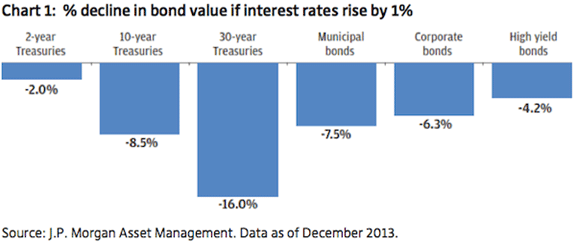
Or, as one commentator put it in 1994 as investors all over the world suffered massive losses as a result of falling bond prices:
The precipitous fall has little to do with inflation – and everything to do with the sudden bursting of a huge speculative bubble in the global fixed-income markets. (Source: Cornerstone)
You may actually wonder who on earth is buying bonds at current levels? With 10- year yields now negative in Switzerland, and 5-year yields negative in several European countries, who in their right mind would buy a bond when you are guaranteed to lose money, assuming you hold it to maturity?
The most likely answer is that investors do not plan to hold these bonds to maturity. They are jumping on a gravy train that has been spectacularly successful over the past few years (chart 2). It is obviously a risky trade, as it is not inconceivable that there will be a stampede by the exit door when the first smoke can be smelled.
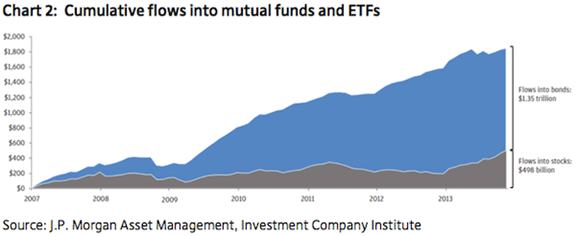
As one investor succinctly put it: “When the door closes, they won’t all fit through the cat flap.”
That is, in my book, a far bigger risk to the bond market than the Fed or other central banks suddenly overwhelming the bond markets with sell orders.
Our expectations for equities
In last month’s Absolute Return Letter I discussed our longer term expectations for equity returns, and it shouldn’t be necessary to repeat myself, so the following will be short and sweet. Suffice to say, we don’t expect equity returns over the next ten years to be nearly as spectacular as they have been for the past 35 years since the equity bull woke again in 1981 after a 15 year slumber.
That does not imply that we expect equity returns to be negative though. Extraordinarily low interest rates will continue to drive many investors into equities and ensure that they do better than they strictly speaking should, given the overall growth in the economy and corporate profits. Over the next ten years, we expect equities to deliver mid-single digit annualised returns.
That should be enough for equities to outperform bonds where our annualised return expectations over the next decade are in the range of -5% to +5%, subject to duration and credit risk.
One of the many implications of this is that the 60/40 model, which has proven immensely popular for the last many years (and for good reasons if you look at past returns in chart 3), is on the way out – at least temporarily. Investors will increasingly look in other directions to achieve the returns they desire (and need).
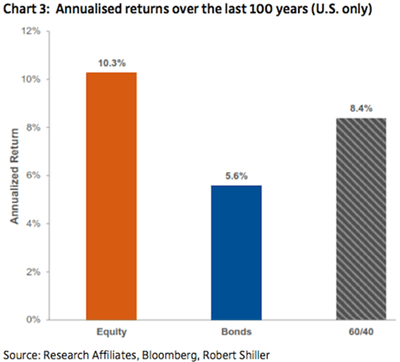
A word or two on LDI
Before I go any further, I need to make an important distinction. Institutions with fixed liabilities (such as many pension funds and life insurers) don’t think of their portfolio as one but two portfolios.
The portfolio matching their future liabilities is called the liability driven investment (LDI) portfolio, whereas the other one is simply called the return portfolio. The reason this is important in the context of this month’s Absolute Return Letter is that, going forward, everything I say will relate only to the return portfolio. The LDI portfolio is structured to address each investor’s specific liabilities and is usually full of cash, swaps and bonds, and I cannot possibly add any value as to how it is best constructed, as everyone’s needs will differ.
The return portfolio is different. This is an area where everyone has the same basic objective – the highest possible return for the amount of risk that one is prepared to take. The rest of this letter should be read as my thoughts on how to construct the return portfolio in a low return environment. A couple of caveats: U.K. law prohibits me from being too specific. Call or email us if you want to take this discussion to the next level. Secondly, if you are a private investor, unfortunately some (but not all) of the following is prohibited land for you. Again, call us if you need clarification.
How David Swensen has changed the style of investing
Approximately 30 years ago, when I moved to London, UK pension plans typically pursued a rather simple investment strategy. Only equities and bonds were considered worthy of a place in the portfolio, and investments were almost entirely domestic. Without having detailed information on other countries, I would be quite surprised if it was much different anywhere else.
Then David Swensen entered the frame. He was recruited by the Yale Endowment in 1985 and gradually established a brand new investment style, based on more diversification and an entry into alternative investments. Yale’s spectacular returns over the following years made people all over the world sit up and listen.
Yale’s results have been widely attributed to its large allocation to alternative investments, and the model has been extensively copied. But, as Forbes observed in a now classic article from 2012 (see here), reading about the Yale model alone doesn’t make you a better investor, just like reading about Tiger Woods doesn’t turn you into a world-class golfer.
As a consequence of disappointing returns amongst many (but not all) institutional investors, the trend has begun to reverse again, and today many institutional investment managers focus more on themes like active vs. passive, smart beta and illiquid alpha than they do on actual investment strategies.
And now to the Holy Grail
I rarely make promises. A long life in investments has taught me the validity of not doing so and, apart from that, in the financial industry we are not supposed to do it in the first place. Having said that, I can (almost) promise you one thing. Equity returns over the next decade or two will, on average, be much lower than the returns we have enjoyed in the great equity bull market of the last 35 years.
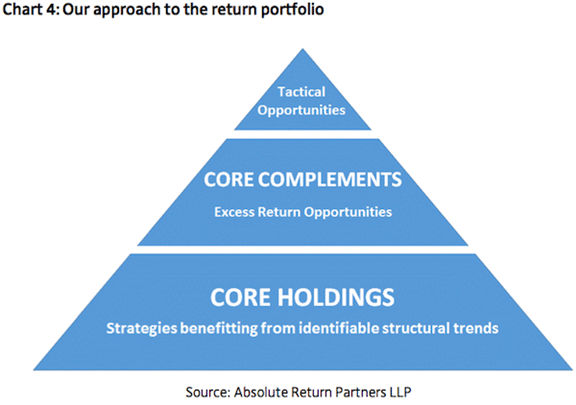
Performing in line with 100-year averages (chart 3) will be challenging enough – and not very likely to happen if you ask me. I could obviously be dead wrong, but I am pretty sure that the extraordinarily good days of yesteryear aren’t going to be repeated anytime soon.
In a low return environment, assuming the objective is still to maximise returns given a pre-defined amount of risk willingness, portfolio construction must be approached somewhat differently (but not massively so). In short, our return portfolio would look as in chart 4 above.
At the bottom of the pyramid, core holdings, which would make up the biggest part of the overall portfolio, would consist of investment strategies likely to benefit from changes in structural trends that we have identified. And, as an added bonus, most investors do not have patience for structural trends, because they are considered too long-term in nature. As a consequence, they are rarely (fully) priced in.
The most important of them all, the ageing of the population, is a typical example. When I speak to investors, their eyes often glaze over when the subject turns to demographics. “Yes, maybe in 30 years’ time” is the response I often get. As if it won’t matter between now and then. Don’t you think that a drop in Germany’s population from over 80 million people today to 65 million in the next 30 years will matter next year? Of course it will, and the ageing process largely explains the very modest growth in domestic German demand at present, even if many prefer to blame modest consumer demand in Germany on the nasty experience the country went through in the 1920s.
The middle section (which we call core complements) we would fill up with investment strategies that, for whatever reason, enjoy excess return opportunities in the current environment (‘excess’ meaning over and above what the risk premium would otherwise suggest). The financial crisis created so many opportunities that investors are advised to allocate more attention to this area than many typically do.
A couple of examples: Since the dark days of 2008-09, investors have been addicted to liquidity. As a result, the illiquidity premium on many less liquid investment strategies continues to be unusually high. Another example emanating from the financial crisis: Regulatory arbitrage. Banks all over the world are being harassed by regulatory authorities (and now and again for good reason, I might add), and that has created numerous opportunities.
At the top of our ‘allocation tree’, I would put various tactical opportunities. We put less emphasis on tactical opportunities than most only because that’s not where we have been most successful over the years. Having said that, being long the U.S. dollar, which has been one of our largest tactical trades over the past 12 months, has been spectacularly successful.
Going forward, one of our tactical ideas is for GBP to weaken. If the Tories come out as winners of the parliamentary elections later this month, Cameron (unless he retires) will have to honour his promise to deliver a referendum on future EU membership, and GBP will most likely weaken as that referendum approaches. If Labour wins, Sterling will also weaken as it always does when Labour is in power.
Structuring the return portfolio this way, i.e. taking advantage of the many opportunities that are a direct result of the financial crisis in a much more systematic way than most do, makes 8-10% in annualised returns feasible even in a low return environment.
There is obviously no one-fits-all solution. Nor do I arrogantly assume that we are right and everyone else is wrong. Having said that, if our return expectations are anywhere near correct, a 60/40 portfolio will return no more than 2-4% annualised over the next decade, and that is certainly not enough to cover the liabilities of most pension funds. Something will have to give.
And, if you believe that I am a touch too pessimistic, take a look at chart 5 below. A 60/40 portfolio has generated less than 5% annualised returns over the last ten years, and that is with the benefits of a major bull market in bonds.
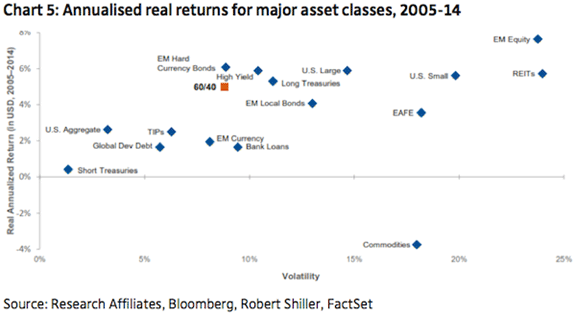
Some ideas to complete the picture
The easy part first: Which asset classes and strategies wouldn’t go into any part of our return portfolio? Bonds and most commodities is the answer.
Bonds at current valuations simply have no place in our return portfolio. If the expected return on bonds is -5% to +5% but with a negative skew (i.e. -5% is more likely than +5%) any bond strategy exposed to the rate of interest – long or short – will struggle to generate attractive returns unless loads of leverage is used, and then it is not for us.
Having said that, certain types of alternative investment strategies that would benefit from rising interest rates – e.g. certain types of lending strategies – would obviously be included in our portfolio.
I would also stay clear of most commodities and that would include gold, which I am often asked about. Slow economic growth and modest inflation levels for years to come combined with a relatively strong U.S. dollar will most likely keep most commodity prices subdued.
As far as equities are concerned, the bull market which has unfolded since March 2009 has strongly favoured the biggest companies (largely because of indexing), whereas more fundamental stock-picking strategies have had a difficult time. When Apple Inc. (AAPL) rises 10%, its market capitalisation goes up by a mind-blowing $75 billion, and passive investors feel inclined to buy more of AAPL because it is now an even bigger percentage of the index, entirely ignoring the fact that AAPL’s P/E ratio has also increased by approx. 2 in the process, making the stock less attractive from a fundamental point of view.
This total disregard for fundamentals will most likely come to an end at some point, but I cannot tell you when. All I know is that, when it happens, you can expect to see major re-alignments in equity valuations.
One fundamental equity strategy that already does well, and has done exceptionally well since 2008-09 is a strategy that pursues the combination of high dividends and low pay-out ratios2 (chart 6).
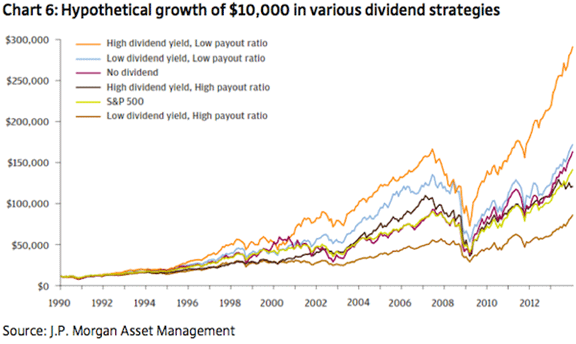
The high dividend appeals to investors hungry for income, and the low pay-out ratio ensures that the company in question can actually afford the attractive dividend, which not every company paying a high dividend can.
Considering the demographic mix in many countries combined with the low interest rate environment, (a) it is no surprise that more and more investors look for equities to deliver the income that bonds don’t, and (b) the drive towards higher dividend paying companies could easily last for another 5-10 years. Therefore companies that pay attractive dividends, and can actually afford to do so, have a big place amongst core holdings in our return portfolio.
And to those who say that the game is largely over, and that you are buying yesterday’s story if you invest in those types of equities now, I say: Look at the past. In the three decades of the 20th century with the lowest economic growth (the 1930s, the 1940s and the 1970s) high dividend paying companies outperformed the overall market in all three instances.
Why should it be any different this time? Not only are we likely to go through a period of rather pedestrian economic growth, but we are also ‘suffering’ from the largest group of near-retirees that the world has ever seen – people who will need a source of reliable income.
In the alternative space, there is a distinguishable trend away from equity-like strategies towards more income-like strategies and, in that respect, we are not any different. We have no room in our portfolio for the biggest alternative strategy of them all – equity long/short – or for that matter any other alternative investment strategy which happens to be highly correlated with equities (and there are quite a few of them).
It really is that simple. If gross equity returns are running at 4-6% annualised, as I expect them to do, and the cost structure is 2+20, equity long/short managers have to deliver an awful lot of alpha to generate a half-decent return to investors. On average, we don’t think they’ll do it.
Obviously, equity long/short managers may be tempted to use the other option available to them – leverage – but it is a major negative in our books if managers can only generate attractive returns on financial assets if applying leverage.
Unfortunately, income-generating alternative investment strategies are few and far between, but they do exist. Even better – if you are looking for strategies with income characteristics but don’t really care if the returns are offered as income or capital appreciation, the number of opportunities rises significantly. Strategies like trade finance, peer-to-peer lending as well as various royalty and leasing strategies all spring to mind.
Final words
Having already referred to David Swensen, I should allow him to have the final word. In his famous book from 2000 “Pioneering Portfolio Management” he made a very good point:
“By reducing pressures to produce in the short run, liberated managers gain the freedom to create portfolios positioned to take advantage of opportunities created by short-term players. By encouraging managers to make potentially embarrassing out-of-favour investments, fiduciaries increase the likelihood of investment success.”
I wholeheartedly agree. So many investors are so short-sighted in their approach that it creates opportunities for the rest of us. And the 2008 crisis has multiplied the number of opportunities that always occur following a bear market by at least a factor of ten.
Having said that, a typical portfolio will almost certainly not deliver the required returns over the next decade. If ‘typical’ means a 60/40 approach, as already mentioned, then 2-4% annualised returns are what can realistically be expected. If ‘typical’ means an entry into alternative investment strategies but only mainstream alternatives such as equity long/short and nothing else, you will almost certainly also end up short of your own expectations.
However, if you take advantage of the sort of opportunities that are mentioned above, 8-10% a year is feasible (I think, but no promises made), but it would require an element of low equity beta and low bond beta investment strategies. Otherwise it would just be a pie in the sky.
Niels C. Jensen
5 May 2015
PS. Alison Major Lépine joined Absolute Return Partners earlier this year from one of the largest UK pension funds. She has been instrumental in reaching many of the conclusions in this month’s Absolute Return Letter. Thank you.
Like Outside the Box?
Sign up today and get each new issue delivered free to your inbox.
It's your opportunity to get the news John Mauldin thinks matters most to your finances.
John Mauldin Archive |
© 2005-2022 http://www.MarketOracle.co.uk - The Market Oracle is a FREE Daily Financial Markets Analysis & Forecasting online publication.



